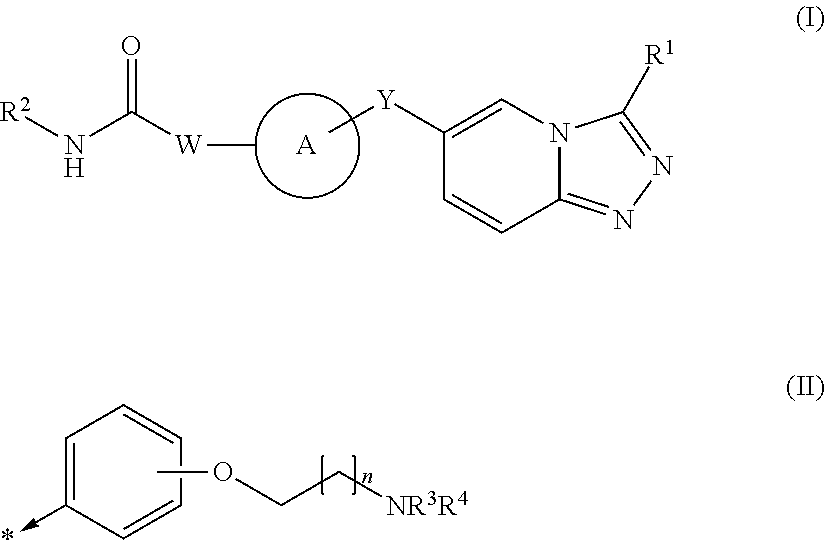Triazolopyridine derivatives and their therapeutic use
a technology of triazolopyridine and derivatives, which is applied in the direction of phosphorous compound active ingredients, drug compositions, biocides, etc., can solve the problems of tnf lethal, cachexia and anorexia, inflammation within the lung environment,
- Summary
- Abstract
- Description
- Claims
- Application Information
AI Technical Summary
Benefits of technology
Problems solved by technology
Method used
Image
Examples
example 1
N-Cyclopropylmethyl-3-{3-[3-(2-morpholin-4-yl-ethoxy)-phenyl]-[1,2,4]triazolo[4,3-a]pyridin-6-ylsulfanyl}-benzamide
[0119]
a. N-(5-Iodo-pyridin-2-yl)-N′-[1-[3-(2-morpholin-4-yl-ethoxy)-phenyl]-meth-(E)-ylidene]-hydrazine
[0120]
[0121]To a suspension of 5-iodo-2-hydrazinopyridine (6.62 g, 0.028 mmol) in EtOH (90 mL) was added 3-(2-morpholin-4-yl-ethoxy)-benzaldehyde (6.63 g, 0.028 mmol). The reaction was heated at reflux for 2 h under nitrogen, then cooled to RT. The resulting precipitate was collected by filtration and washed with EtOH to afford the title compound (10.93 g, 86%) as a white solid. LCMS (Method 1): Rt 2.37 min, m / z 453 [MH+]. 1H NMR (300 MHz, CD3OD): δ 8.24 (1 H, d, J 2.2), 7.90-7.84 (2H, m), 7.36-7.18 (3H, m), 7.12 (1H, d, J 8.8), 6.94-6.89 (1H, m), 4.19 (2H, t, J 5.4), 3.72 (4H, t, J 4.6), 2.83 (2H, t, J 5.4), 2.62 (4 H, t, J 4.6).
b. 6-Iodo-3-[3-(2-morpholin-4-yl-ethoxy)-phenyl]-[1,2,4]triazolo[4,3-a]pyridine
[0122]
[0123]To a solution of Example 1 step a (10.93 g, 24.16 ...
example 10
1-(5-tert-Butyl-2-p-tolyl-2H-pyrazol-3-yl)-3-(4-{3-[3-(2-morpholin-4-yl-ethoxy)-phenyl]-[1,2,4]triazolo[4,3-a]pyridin-6-ylsulfanyl}-phenyl)-urea
[0128]
a. 3-(6-Bromo-[1,2,4]triazolo[4,3-a]pyridin-3-yl)-phenol
[0129]
[0130]Boron tribromide (1 M in DCM, 13.1 mL, 13.1 mmol) was added slowly to a stirred solution of 3-(3-benzyloxy-phenyl)-6-bromo-[1,2,4]triazolo[4,3-a]pyridine (1 g, 2.63 mmol) in DCM (5 mL) at −78° C. The reaction was allowed to warm up to RT, stirred for 24 h, and treated with sat. NaHCO3 solution until pH>7. The product was extracted with DCM:MeOH 9:1 (mL), dried (MgSO4), and concentrated in vacuo. Purification of the crude residue by FCC (DCM:MeOH, 1:0 to 9:1) afforded the title compound (350 mg, 46%) as a yellow solid. LCMS (Method 2): Rt 2.65 min, m / z 290 and 292 [MH+].
b. 6-Bromo-3-[3-(2-morpholin-4-yl-ethoxy)-phenyl]-[1,2,4]-triazolo[4,3-a]pyridine
[0131]
[0132]A mixture of Example 10 step a (250 mg, 1.21 mmol), N-(2-bromoethyl)morpholine hydrochloride (306 mg, 1.32 mmo...
example 12
1-(5-tert-Butyl-2-p-tolyl-2H-pyrazol-3-yl)-3-(6-{3-[3-(2-morpholin-4-yl-ethoxy)-phenyl]-[1,2,4]triazolo[4,3-a]pyridin-6-ylsulfanyl}-pyridin-3-yl)-urea
[0137]
a. 3-[3-(2-Morpholin-4-yl-ethoxy)-phenyl]-6-(5-nitro-pyridin-2-ylsulfanyl)-[1,2,4]triazolo[4,3-a]pyridine
[0138]
[0139]To a solution of Example 1 step b (300 mg, 0.67 mmol) in THF (5 mL) at 0° C. was added dropwise 2 M isopropylmagnesium chloride in Et2O (335 μL, 0.67 mmol). The reaction was stirred at 0° C. for 1 h, then 2,2′-dithiobis(5-nitro-pyridine) (227 mg, 0.73 mmol) was added. The reaction was allowed to warm to RT and stirred for an additional 1 h then diluted with EtOAc (10 mL). The organic layer was washed with 1 M NaOH (10 mL), brine (10 mL), dried (MgSO4), and concentrated in vacuo. Purification by reverse phase preparative HPLC (Method 3) afforded the title compound (50 mg, 16%) as a yellow solid. LCMS (Method 1): Rt 2.33 min, m / z 479 [MH+]. 1H NMR (400 MHz, CD3OD): δ 9.16 (1H, d, J 2.6), 8.80 (1H, t, J 1.2), 8.41 (1H...
PUM
| Property | Measurement | Unit |
|---|---|---|
| mass median aerodynamic diameter | aaaaa | aaaaa |
| body weight | aaaaa | aaaaa |
| concentration | aaaaa | aaaaa |
Abstract
Description
Claims
Application Information
 Login to View More
Login to View More - R&D
- Intellectual Property
- Life Sciences
- Materials
- Tech Scout
- Unparalleled Data Quality
- Higher Quality Content
- 60% Fewer Hallucinations
Browse by: Latest US Patents, China's latest patents, Technical Efficacy Thesaurus, Application Domain, Technology Topic, Popular Technical Reports.
© 2025 PatSnap. All rights reserved.Legal|Privacy policy|Modern Slavery Act Transparency Statement|Sitemap|About US| Contact US: help@patsnap.com



